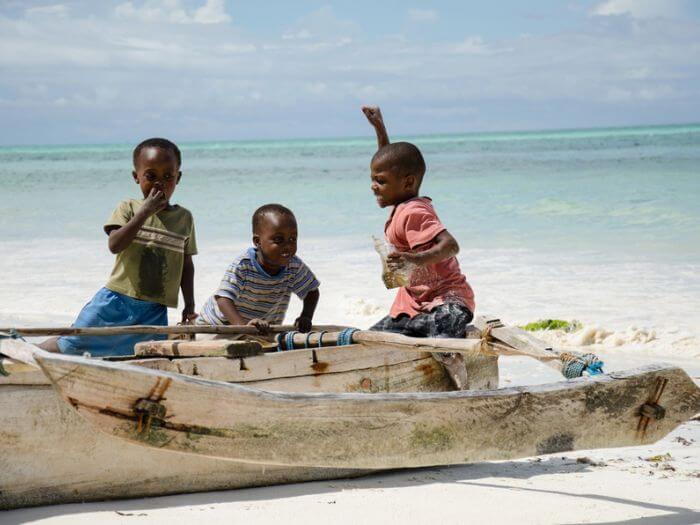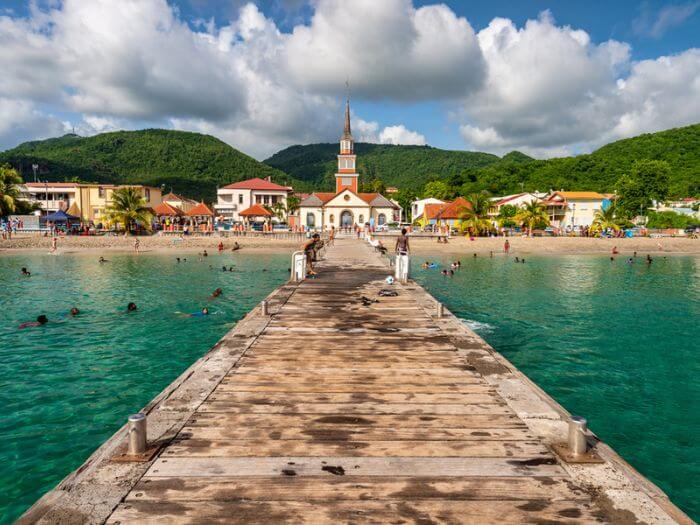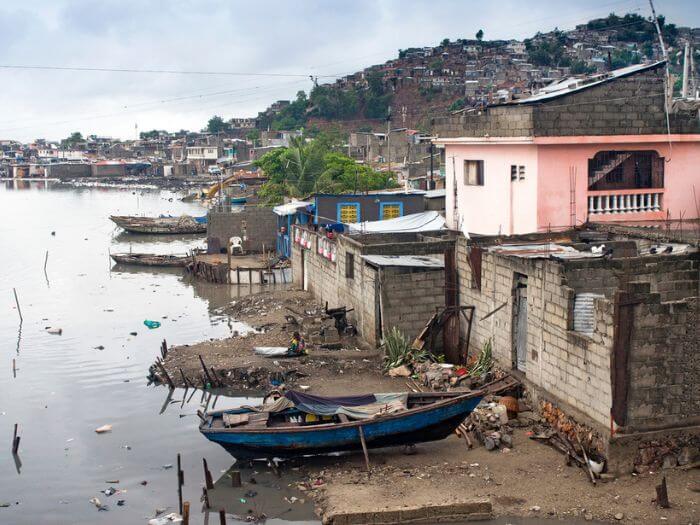When you learn French, you usually learn Standard or Metropolitan French, the version of the language that most French speakers understand.
However, there are many other dialects of French in use around the world – and there are also quite a few French creoles.
But what is French Creole? Where is it spoken? And how are creoles related to French?
In this post, I have answers to questions like these and more as I delve into the fascinating topic of French Creole.
Pro Tip
By the way, if you want to learn French fast and have fun, my top recommendation is French Uncovered which teaches you through StoryLearning®.
With French Uncovered, you’ll use my unique StoryLearning® method to learn French through story…not rules. It’s as fun as it is effective. If you’re ready to get started, click here for a 7-day FREE trial.
Table of Contents
What Is A Creole?
Before we get to talking about French Creole, let’s start by taking a step back and looking at a more basic question – what is a creole?
A creole is a language that arises when people with no common tongue come into contact and need to find a way to communicate.
First, they develop a pidgin, a simplified form of language that dispenses with things like complicated grammar and large vocabularies and uses only what’s necessary for basic interactions.
(The word “pidgin” itself comes from a Chinese pronunciation of the English word “business”. It was first used to describe Chinese Pidgin English, which was primarily used for commercial interactions between foreigners and locals in southern China from the 17th to 19th centuries.)
The important thing to note about pidgins is that they aren’t considered full and proper languages. They don’t have standardised grammar or vocabularies, and even things like word order aren’t fixed – the main focus is on getting your point across.
You can’t use a pidgin to talk about complex matters or have detailed conversations. Pidgins are simple languages of convenience used by people who need to communicate with each other on only a basic level.
From Pidgin To Creole
Historically, pidgin languages have sprung up in many parts of the world. However, when the people using pidgins have children, something special happens.
Regardless of the language they speak at home, when children are out playing with others, they use the local pidgin to communicate. And very quickly, the children transform the pidgin into a proper language.
Essentially, the children “fill in the blanks”, creating a new language of their own, which they then grow up speaking as natives.
These new languages tend to have simplified grammar with fewer complications like irregular verb conjugations. But the rules of grammar themselves become regular, fixed and understood by all, and the vocabulary becomes much expanded and universally recognised.
When this happens, a unique and fully-fledged language is born that can be used to discuss complex matters, just like any other recognised language. And at this point, the language passes from being a pidgin to what’s known as a creole.

Creole Formation
Usually, the bulk of the vocabulary of a nascent creole comes from the most prestigious of the languages involved or from the language of the ruling class. And in technical terms, the language providing most of the vocabulary is known as the “lexifier”.
This vocabulary tends to be superimposed onto the grammar of the other less prestigious languages that are present, and the resulting grammatical mix then evolves into something unique and original.
This is why you may be able to pick out many words of a French based creole language if you speak French. But the sentence structure and other grammatical features are likely to be unfamiliar and often incomprehensible.
Many such languages appeared during the Age of Discovery and the period of the Atlantic slave trade, which is why many of them show the influences of languages like English, French, Portuguese, Spanish and Dutch.
However, other creoles exist that were influenced by non-European languages such as Arabic, Chinese or Malay.
What Creole Isn’t
Now we know what a creole is, it’s also important to understand what a creole isn’t to clear up any misconceptions.
First, a creole isn’t a dialect of any of the languages it derives from. So, for example, French based creole languages aren't dialects of French, like Canadian French or African French or those found in other French-speaking countries or regions of France.
In addition, a creole isn’t some kind of degenerate or inferior form of a purer language – although they were often thought of in this way in the past.
When a creole arises, it should be considered a full and proper language with as much value and merit as any other.
Interestingly, there's a serious and credible theory that English is, in fact, a creole that was formed through a mixing of Common Brittonic (a Celtic language once spoken in the British Isles), Old English (the language of the Anglo-Saxons), Old Norse and, later, Norman French.
This means if English is your native tongue, there’s a strong possibility that your first language is actually a creole, which should make you think twice before looking down on other creole languages!
Finally, it should be clear by now that “Creole” isn’t a single language but many.
There are thought to be around 100 creole languages in existence today, with quite a few of them heavily influenced by French. So a better title for this post might have been “French Creoles” in the plural rather than the singular.
That said, in local contexts, when people say “creole”, they're usually referring to their local creole language or culture. So if you’re in Martinique, for example, and hear someone talking about creole, it’s highly likely they mean Martinique Creole rather than creoles in general.

What Is French Creole?
So what is French Creole? Or more accurately, as I’ve just pointed out, what are French creoles?
French creoles are languages that have arisen in places of French influence where the use of French was dominant – and as a result, where French served as the lexifier.
Interestingly – and logically – for historical reasons, these creole languages were influenced by the French of the 17th and 18th centuries rather than modern French since this was the period when France was most active as a colonial power.
In linguistic terms, it can sometimes be difficult to say that a language is a “French creole” since it may also have been significantly influenced by languages other than French.
However, if a creole has French as its lexifier – and so has a vocabulary derived mainly from French – we can call it a French creole. It's thought that over 15 million people around the world speak such languages natively.
As you might expect, due to historical reasons, most of these languages are found in the Caribbean and the Indian Ocean since this is where France was most influential during the colonial period.
So let’s look at some of the most important French creole languages now spoken.
Haitian French Creole

Haitian Creole, known as créole haïtien in French and kreyòl ayisyen locally, is one of the two most widely spoken creole languages in the world today (the other being Nigerian Pidgin, an English-based creole).
It's spoken in Haiti, where it's the first language of most people in the country, and it's also heard in other parts of the Caribbean that were connected to France.
It's a particularly good example of a creole language and how they develop since it displays many of the characteristics I mentioned above.
Haiti, then Saint-Domingue, was one of France’s most important and lucrative colonial possessions.
From the end of the 17th century in particular, many enslaved Africans from different parts of West Africa were transported to the island to work on the plantations. And since they had no common language to speak among themselves, they tried to use French to communicate.
However, since they were never formally taught French, they ended up adopting and adapting French vocabulary while retaining a grammatical structure more typical of their various native languages from West Africa.
The resulting language is now spoken by up to 12 million people in three main dialects. And although much of the vocabulary is recognisably French, French and Haitian creole are not mutually intelligible.
Haitian Creole has also suffered much of the same stigma as many other creole languages, with the French plantation owners viewing it largely as an inferior and corrupted form of French, an idea that persisted even long after independence.
Although Haitian Creole speakers sometimes view French as an unwelcome part of the legacy of the colonisers, until recently, education in Haiti was conducted in French despite it not being most people’s first language.
However, the situation is changing, and Haitian Creole is now seen as a true and valued language that its speakers can take pride in, and it is also more commonly used in official or formal contexts.
Haitian Creole vs French: Examples of Haitian Creole vocabulary
- Akoz (French parce que, English “because”) – similar to French à cause de and English “because”, also used in Martinique Creole
- Batiman (French, navire, bateau, English “boat”, “ship”) – although it sounds more like the French word batiment
- Gran-moun (a word used to describe elderly people in general)
- Jou (French jour, English “day”) – we can easily see where this word comes from!
- Syèl (French ciel, English “sky”) – another easy one to guess, also used in Guadeloupe Creole
Lesser Antillean Creole
Lesser Antillean Creole, or sometimes just Antillean Creole, is a language spoken on many of the islands of the Lesser Antilles as well as in other places including Haiti, French Guiana and Venezuela.
Antillean Creole French arose after France began establishing colonies in the area, starting with the island of Martinique in 1635, and the subsequent transportation of large numbers of enslaved West Africans to work on plantations on the islands.
Due to the jostling of colonial powers, islands in the Lesser Antilles changed hands throughout the following centuries. As a result, this creole language is now spoken even on some islands where English became the predominant or official language.
Although French provided much of the vocabulary for the language, its development was also influenced by English, local Caribbean languages and West African languages, the latter providing much of the grammatical structure.
Lesser Antillean Creole is partially mutually intelligible with Haitian Creole since they share a lot of vocabulary and have similar grammar – which is understandable since Haiti, part of the Greater Antilles, lies in close geographical proximity and shares a broadly similar history.
However, speakers of Haitian Creole and Lesser Antillean Creole will still have difficulties communicating with one another due to differences in some of the most important high-frequency vocabulary and commonly used grammatical structures.
Features of Lesser Antillean Creole include the use of verbs only in the infinitive form, all nouns becoming masculine and adjectives and adverbs being the same.
The archipelagic nature of the area has led to different dialects developing on the various islands, which diverge mostly in terms of vocabulary. Here are a few of the most important.
Saint Lucian Creole

Saint Lucian Creole – or kwéyòl – is spoken mainly on Saint Lucia, an island where English is the official language.
The vocabulary comes mostly from French, but its grammar is more influenced by West African languages, and it also displays influences from English as well as the local Carib language.
It is very similar to other creole varieties spoken on nearby islands, and speakers of other versions of Lesser Antillean Creole have no problem understanding it.
Saint Lucian Creole pronouns don’t change according to grammatical function, so, for example, mwen means “I”, “me” and “my”. Possessives come after the noun, so jan mwen means “my friend”. Much of the rest of the grammar is similarly quite different from French.
Examples of Saint Lucian Creole vocabulary
- Kanna (French canard, English “duck”) – obviously derived from the French word
- Lèg (French aigle, English “eagle”) – coming from the French word with the definite article attached, l’aigle
- Motoka (French voiture, English “car”) – from the English “motorcar”
Martinique Creole
Very similar to Saint Lucian Creole with which it is almost 100% mutually intelligible, Martinique Creole is the version of Lesser Antillean Creole spoken mainly on the French island of Martinique.
Examples of Martinique Creole
- Séyé (French essayer, English “try”) – derived directly from the French word
- Karésé (French caresser, English “hug”) – derived from the French; the word miyonnen is a synonym
- Koulè wob koton tala bel toubonman (French, le coloris de cette robe en coton est fabuleux !, English “the colouring of this cotton dress is wonderful!”) – from the cover of the Assimil guide to Martinique Creole conversation
Guadeloupe Creole
Another language that is very similar to the other forms of Lesser Antillean Creole, this variant is spoken on the French island of Guadeloupe.
Examples of Guadeloupe Creole
- Émab (French aimable, English “friendly, likeable”)
- Enfimyèz (French infirmier, infirmière, English “nurse”) – also used in Martinique Creole
- I an dengon an-mwen toulongalé (French il me tourne autour, English “he’s hanging around me”) – from the cover of the Assimil guide to Guadeloupe Creole conversation
French Guianese Creole
Spoken primarily in French Guiana as well as in neighbouring parts of Brazil and Suriname, French Guianese Creole is similar to Lesser Antillean Creole and is mutually intelligible with its different varieties but also diverges slightly more prominently.
Examples of French Guianese Creole vocabulary
- Douri (French riz, English “rice”) – from the French du riz, “some rice”
- Bonswè (French bonsoir, English “good evening”) – from the French
- Lapli ka tonbé (French il pleut, English “it’s raining”) – from the French la pluie tombe, “the rain falls”
Louisiana Creole

Heard mostly in the US state of Louisiana – and not to be confused with Louisiana French, which is a true dialect of French and not a creole – Louisiana Creole has fewer than 10,000 speakers and is in danger of disappearing completely.
Most younger speakers in the area now speak either French or English rather than Creole as their first language. However, some efforts are being made to preserve and revive the language.
Although French provides much of the vocabulary, some words are derived from local Amerindian languages as well as West and Central African languages.
It is less mutually intelligible with the Caribbean French-based creole languages that I’ve mentioned above – although there are some similarities.
Examples of Louisiana Creole
- Bonjou (French bonjour, English “hello”) – a word that would be understood by speakers of French creoles everywhere
- Konmen lêz afær? (French comment ça va?, English “how are you?”) – from the French comment les affaires?, literally “how things?”, “how business?”
Mauritian Creole
Mauritian Creole, known locally as kreol morisien, is the creole language of Mauritius, the small island country in the Indian Ocean to the east of Madagascar.
When the island was discovered, probably by Arab sailors, it was uninhabited. The Portuguese visited it in 1503, the Dutch claimed the island in 1598, the French took over in 1715 and it was ceded to the British in 1810.
During the period while the island was under French and then British control, large numbers of enslaved Africans were transported there to work on plantations, and a French-based creole evolved.
The island gained independence in 1968, and nowadays, Mauritian Creole is spoken by around 90% of the population, alongside English (which is used for administration and education) and French (which is mostly used in the workplace and the media).
Mauritian Creole, like other creole languages of the Indian Ocean, is quite different from those spoken in the Caribbean and isn’t mutually intelligible with Caribbean creoles.
In terms of grammar, it differs from French in many ways. For example, there is no plural form of nouns and verbs don’t change according to tense or person.
Notably, some words in Mauritian Creole come from Tamil, something obviously not present in the creoles of the Americas.
However, there are also many similarities with Caribbean creoles despite the independent development of the languages, something of great interest to scholars who study creoles.

Examples of Mauritian Creole
- Laba (French là-bas, English “over there”)
- Deor (French dehors, English “outside”)
- Ki nou pou manze? (French que va-t-on manger ?, English, “what are we going to eat/what shall we eat?”) – from the cover of the Assimil guide to Mauritian Creole conversation
Réunion Creole
Réunion is an island of similar size to Mauritius that lies to its southwest.
The two islands share a similar colonial history, but Réunion was not ceded to the British and subsequently chose to remain part of France rather than declare independence.
Kréol rénioné, as it is known there, is heavily influenced by French vocabulary but also shows influences from Malagasy, Hindi, Portuguese, Gujarati and Tamil.
It's primarily a spoken language and doesn’t have a standardised spelling system – although efforts are underway to rectify this.
However, despite being widely spoken, Réunion Creole is not recognised as an official language – the only official language of the island is French.
Examples of Réunion Creole
- En sort'a zote (French, débrouillez-vous, English “work it out for yourself”)
- Sa in shalër i bat ater ! (French quelle chaleur assommante !, English “what oppressive heat!”) – from the cover of the Assimil guide to Réunion Creole conversation
Seychellois Creole

Known locally simply as kreol, Seychellois Creole has long enjoyed a higher status in the Seychelles, where it is spoken, than its cousins on Mauritius and Réunion.
In the Seychelles, it's considered an official language alongside English and French. And the Seychelles government has taken steps to preserve and promote the language since the country achieved independence in 1976.
It now has standardised orthography and grammar. And it's also the working language of the National Assembly, the country’s legislative body.
Tayo
Tayo is a French-based creole spoken in New Caledonia, an archipelago administered as a French collectivity lying around 750 miles east of Australia and a little to the southwest of Vanuatu in the Pacific Ocean.
It's spoken by only around 3,000 people and combines mainly French vocabulary with Melanesian grammatical structures.
There are also notable similarities with Réunion Creole, and there is some debate concerning whether the language evolved directly from contact with French or from contact with speakers of Réunion Creole who migrated to the islands.

Can You Understand French Creoles If You Speak French?
From everything I’ve said so far, it should by now be obvious that speaking one of the languages a creole is derived from will not mean you can speak the creole or even understand much of it at all. Although you'll probably be able to recognise quite a few vocabulary items.
To take a different example, one of the three official languages of Papua New Guinea is what’s known as Tok Pisin, a language with English as its lexifier. You may be able to guess that nem bilong mi Jane means “my name is Jane” and yu orait? means “how are you?”.
However, dispela em hamas? (how much is this?) is a bit more difficult to understand.
(You may also be able to guess that the name of the language comes from the English “talk pidgin”, although this really translates as “pidgin speak” or “pidgin language”. However, Tok Pisin is not actually a pidgin but rather a true creole.)
In the same way, if you speak French, you might be able to recognise a few words, especially when you see them written down. But if you want to speak a creole language fluently, you will have to learn it just like any other foreign language.
Of course, knowing French will give you a big advantage when it comes to vocabulary. But if you suddenly find yourself surrounded by people speaking their own creole, you are unlikely to be able to understand very much at all.
What's more, words in a creole language often take on completely new meanings. So even if you recognise the sound of a word, you still might misunderstand its meaning.
If you want to hear the similarities (or mainly differences) between Haitian Creole and French, close your eyes and give this video of someone speaking Haitian Creole a go.
I managed to pick out a few words that I recognised from French, but beyond that, I had no idea what she was saying!
All of this also means that a person who speaks one type of French creole won’t be able to understand somebody who speaks another one because they are completely different languages. Although those spoken in neighbouring regions often have many similarities.
Fascinating And Vibrant New Languages
Although French creoles are heavily influenced by French, especially in terms of vocabulary, they are not merely dialects of French. And they certainly aren’t inferior versions of French.
Rather, they are fascinating and vibrant languages in their own right that have arisen through the mixing of peoples from different parts of the world, reflecting their combined linguistic and cultural heritage.
If you speak French, it doesn’t mean you will be able to speak or understand any of the French creole languages, although it may give you a head start if you want to try to learn French creole.
And if you master even a few words of a local creole when you visit, you are sure to surprise and delight the locals there for making the effort to learn their unique native tongue.

Olly Richards
Creator of the StoryLearning® Method
Olly Richards is a renowned polyglot and language learning expert with over 15 years of experience teaching millions through his innovative StoryLearning® method. He is the creator of StoryLearning, one of the world's largest language learning blogs with 500,000+ monthly readers.
Olly has authored 30+ language learning books and courses, including the bestselling "Short Stories" series published by Teach Yourself.
When not developing new teaching methods, Richards practices what he preaches—he speaks 8 languages fluently and continues learning new ones through his own methodology.










































